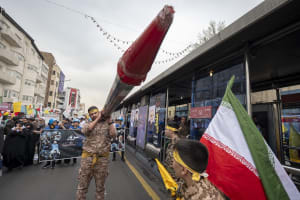Is US preparing a weapons embargo on Israel? Blinken demands more Israeli humanitarian aid for Gaza from DM Gallant
Humanitarian aid to Gaza is a point of contention between US and Israel due to Hamas seizures of aid trucks

U.S. Secretary of State Antony Blinken and Defense Minister Yoav Gallant discussed the situation in the Gaza Strip during a call on Monday evening, with an emphasis on the issue of humanitarian aid, in light of an approaching U.S. deadline for Israel to improve the humanitarian situation in northern Gaza or face restrictions in military aid.
The official readout of the phone conversation between Blinken and Gallant did not mention any threat to withhold military aid, instead proclaiming “the United States’ ironclad commitment to Israel’s security against threats from Iran and Iran-backed proxy groups.”
“The Secretary and Defense Minister discussed the dire humanitarian conditions in Gaza,” the readout states. “The Secretary reviewed actions Israel has taken to date and urged further actions to substantially increase and sustain humanitarian aid – including food, medicine, and other essential supplies – to civilians across all of Gaza.”
According to the statement, Blinken also “emphasized the importance of ending the war in Gaza and bringing all of the hostages home, as well as charting a path forward in the post-conflict period that allows the Palestinian population in Gaza to rebuild their lives and advances governance, security, and reconstruction.”
U.S. State Department Spokesman Matthew Miller said Monday evening that Israel has not improved the humanitarian situation in northern Gaza.
“As of today, the situation has not significantly turned around,” Miller said in a press briefing while hinting at a possible embargo.
“We have seen an increase in some measurements, we’ve seen an increase in the number of crossings that are open, but just if you look at the stipulated recommendations that are in the letter, those have not been met.”
Miller was referring to a letter from Blinken and Defense Secretary Lloyd Austin to Gallant and Strategic Affairs Minister Ron Dermer, instructing Israel to improve the humanitarian situation in northern Gaza or risk the supply of U.S. weapons being impacted.
One of the stipulations called for the entry of 350 aid trucks per day total into Gaza through all crossings.
The 30-day deadline for the letter is approaching in about one week, after which, the U.S. could restrict weapons and ammunition supplies to Israel.
The issue of humanitarian aid has been a point of contention between Israel and the United States since the beginning of the war, with the U.S. demanding a constant supply of humanitarian goods to the Strip, despite evidence that much of the aid is being confiscated by Hamas.
Earlier in the war, U.S. officials denied reports of Hamas stealing aid, which led the IDF to begin documenting occurrences.
In September, N12 ran a series of articles about Hamas’ seizure of humanitarian aid in the Gaza Strip, revealing that Hamas is capturing as much as half of the aid entering the Strip.
It revealed a recording of a phone call between two Hamas operatives complaining about the lack of storage space to keep all the goods the group had confiscated.
“In addition to the fuel trucks, we have trucks loaded with goods,” one of the operatives says. “We have everything for now... we don't have space in the warehouse because it's already packed with full stock. We are waiting for the order to start moving.”
“It's hard to organize them at Samer’s,” the second replied. “There are reception issues. If you can organize them elsewhere, do it.”
The terrorist answered, “Can't you take them to Khan Younis, or will that delay things, for example?”
N12 also reported that Israeli authorities estimate that as of September, Hamas had already made as much as $500 million on the sale of confiscated humanitarian goods through agents working in the food markets.
Humanitarian aid being sold in Rafah, Gaza.
— Hananya Naftali (@HananyaNaftali) March 19, 2024
Israel sends aid, Hamas steals it and then sells it to people.
Free Gaza from Hamas. pic.twitter.com/RjcZB0MUq1
The influx of money was enough to allow Hamas to pay the salaries of new recruits during its year-long war against Israel.
Despite international objections to the decision to close UNRWA offices in Israel and cut all ties with the organization, the evidence that Hamas operatives have infiltrated UNRWA at various levels, and the ubiquitous presence of UNRWA supplies in Hamas bunkers and tunnels, indicates that the UN body was incapable of preventing aid from reaching the hands of Hamas.
Israel, especially through the Office of Coordination of Government Activities in the Territories (COGAT), has pushed back against claims that it is restricting aid into Gaza, or that there are famine conditions in northern Gaza. One problem appears to be the U.S. government’s reliance on UN figures to assess the number of aid trucks entering Gaza.
COGAT has released evidence that the United Nations is only counting the trucks that it picks up and delivers, not the number of trucks crossing the border. It also released footage demonstrating that the UN and its agencies in Gaza are failing to pick up and deliver all the aid transferred to the Gaza side of the border.
In mid-October, COGAT wrote in a post on 𝕏 that in northern Gaza alone, five bakeries are producing a total of 1.3 million pita breads per day. The total population in all of Gaza shortly before the outbreak of the war was estimated to be around 2.2 million. Most Gaza civilians have evacuated to southern Gaza, with over half estimated to be in the humanitarian zone, al-Mawasi.
With approximately 100,000 people remaining in northern Gaza, according to UN estimates, the current food supply appears sufficient to prevent starvation.

The All Israel News Staff is a team of journalists in Israel.














